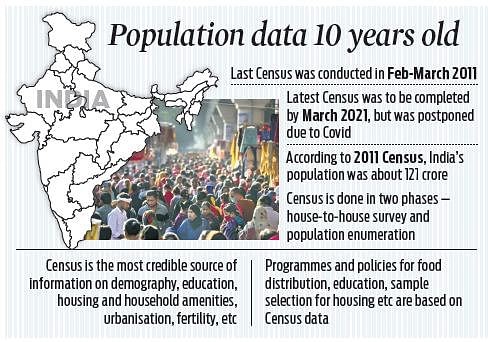- Courses
- GS Full Course 1 Year
- GS Full Course 2 Year
- GS Full Course 3 Year
- GS Full Course Till Selection
- Online Program
- GS Recorded Course
- NCERT (Recorded 500+ Hours)
- Polity Recorded Course
- Geography Recorded Course
- Economy Recorded Course
- AMAC Recorded Course
- Modern India, Post Independence & World History
- Environment Recoded Course
- Governance Recoded Course
- Science & Tech. Recoded Course
- International Relations and Internal Security Recorded Course
- Disaster Management Module Course
- Ethics Recoded Course
- Essay Recoded Course
- Current Affairs Recoded Course
- CSAT
- 5 LAYERED ARJUNA Mentorship
- Public Administration Optional
- ABOUT US
- OUR TOPPERS
- TEST SERIES
- FREE STUDY MATERIAL
- VIDEOS
- CONTACT US
DELAYING CENSUS IN INDIA
DELAYING CENSUS IN INDIA


Latest Context
According to the United Nations Population Fund, India will become the most populous country in the world by the middle of this year. Against this background, It has become a dire need for India to have an exact data population to make its policy effective in order to manage the country in a more efficient manner. Due to Covid-19, it has been delayed that causing significant concerns.
Census
- Definition: It is a total process of collecting, complying, analyzing, and disseminating demographic, economic, and social information about all persons in a country at a given point of time.
- Importance: It serves as a base upon which the progress of any country is reviewed by analyzing the monitoring of the various schemes, policies and programs of the government launched for its people.
Phases: Census of the population is carried out in two phases
- House listing/Housing Census: Under this category, the objective is to collect the data of all buildings whether temporary or permanent according to their type, amenities and assets.
- Population Counting: Under this category, detailed information on each individual residing in the country, Indian national or otherwise is collated. It is carried out after making a list of all households that are surveyed.
Frequency
- First census was conducted in 1881, by W.C. Plowden, Census Commissioner of India. After this, the census is conducted after every ten years. Under the legal framework of The Census of India Act of 1948 Population Census is carried out. But no timing or periodicity has been mentioned under it.
- In countries like the US, and the UK, a 10-year frequency is followed in many countries but some countries like Australia, Canada, and Japan conduct it every five years.
Nodal Ministry: In India, the Office of the Registrar General and Census Commissioner, Ministry of Home Affairs conducts the Population Census. Until 1951, the Census Organization was set up on an ad-hoc basis for each Census.
Significance of Census
- Exact and Authentic Data: The population census provides primary and authentic data upon which various statistical analyses are conducted. Furthermore, this data is very important for planning, decision-making, and development initiatives taken by the government in various sectors like administration, economy, and social welfare. Reliable and up-to-date data is very crucial for developing various indicators and indices used in different facets development of India.
- Businesses Houses: It is also important for business houses and industries to strengthen their planning for their business penetration into areas that have not been explored or are yet to be explored.
- Allocation of Grants: The Finance Commission provides grants to the states on the basis of population figures available from the Census data.
- Demarcation of Constituencies: It is used for demarcating constituencies and allocation of representation in government bodies. In addition, its importance is highlighted by the fact that on this basis the number of seats is determined for reserving for Scheduled Castes (SCs) and Scheduled Tribes (STs) in Parliament, State legislatures, local bodies, and government services.
- The reservation of seats for SCs and STs is based on their proportion in the population in the case of panchayats and municipal bodies. Population census encourages proportional representation and promotes inclusivity in the political and administrative systems.
Consequences of Delaying Census
- Political Misrepresentation: It may result in delays in reserving the seats for SCs and STs in various governing bodies. Census 2011 is getting used which may result in inaccurate seat reservations. The towns and panchayats where there have been significant changes in population composition over the last decade will face more problems.
- Ineffective Policy Formulation: Delaying in conducting the population census may result in a lack of exact data creates challenges in analyzing trends and making informed policy decisions. Old data will not be accurate for a constantly changing scenario in various aspects and is not reliable for developing accurate indicators on India to measure the efficacy and efficiency of all kinds of developmental initiatives.
- Counting of Buildings/Houses: In India, house listing is very crucial because the country lacks a robust address system. In the absence of exact and accurate data, it will be very difficult to know the changes that have occurred in a particular demographic area occur over time. It can result in a less reliable foundation for subsequent population enumeration and data collection.
- Welfare Measures: It will affect negatively government schemes and programs which in turn lead to unreliable estimates from other surveys on consumption, health and employment, which depend on census data to determine policy and welfare measures. Many persons are excluded from the welfare schemes and Public Distribution System (PDS) which shows poor implementation of the programs.
- Lack of Migration Data: Data based on Census 2011 couldn't provide answers to important questions relating to patterns of migration. Covid lockdown led to a high migration of workers leaving cities and walking back to their villages highlighting their challenges. The government does not have exact data on the stranded migrants and their requirements for food relief and transportation support.
Way Forward
- Efforts should be made to use latest technology and advanced methods to streamline the data collection process.
- On priority basis, the government should conduct the Census at the earliest possible time.
- Necessary resources and manpower to ensure a smooth and efficient Census operation should be allocated by the government.
- To complete the Census on right time is crucial for accurate data,effective governance, inclusive development, and informed policy decisions in various sectors.

Prelims
Q. Consider the following statements: (2009)
1. Between Census 1951 and Census 2001, the density of the population of India has increased more than three times.
2. Between Census 1951 and Census 2001, the annual growth rate (exponential) of the population of India has doubled.
Which of the statements given above is/are correct?
(a) 1 only
(b) 2 only
(c) Both 1 and 2
(d) Neither 1 nor 2
Ans: (d)


